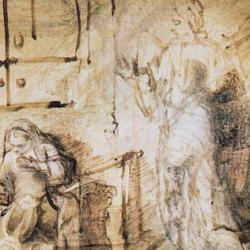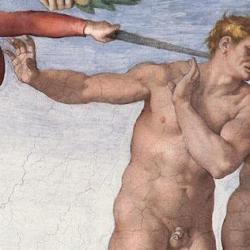As Guy Stroumsa describes it (A New Science), comparative religion originates from a combined political and intellectual challenge to European thinkers. First, the wars of religion led some to question the primacy of Christianity and to search for some religious (or non-religious) substitute to serve as civil religion. Second, the discovery of the Americas challenged European accounts of history and religion: They had to explain the similarities between biblical and Indian religion, and to explain how the Indians got the religions they had.
Genesis 10 – the table of nations descended from Noah’s sons – was the go-to text. European thinkers “invested the Genesis story of Noah’s sons with a new, capital importance. This story served as the basis for their reflection on the origins of ethnic taxonomies as well as of languages, cultures, and religions throughout the various continents. The biblical story of the postdiluvian dispersal of humankind permitted the notion of the original unity of humankind” (78). The connections were often quite specific: “From Arias Montano to Gregorio Garcia, Spanish thinkers applied Genesis 10 quite directly to the New World and its populations.” They also sought to trace parallels between Indian religions and the ancient religion recounted in the Bible.
One of the most extended discussions is found in Phaleg, the first volume of Samuel Bochart’s Geographia Sacra (1646). Stroumsa summarizes the argument: “Bochart offers a highly detailed commentary on Genesis 10 and the origins of all peoples. The book is divided into four parts: the division of the earth between the three sons of Noah, followed by detailed discussions of the sons of Shem, Japheth, and Ham.” Operating on the principle that truth is always first, he concluded that “the gods of pagan antiquity would be understood as secondary, as derivatives that should be explained by the Bible. In the first chapter, Bochart set to show that the Greek myth of Chronos (Saturn) and his sons, Jupiter, Neptune, and Pluto, who divide the world between them, represents a transformation of the story of Noah’s sons, Shem, Ham, and Japheth. Neptune (Poseidon) . . . is identical to Japheth. Referring to Hebrew, but also to Aramic and Arabic, Bochart claimed to show that the Semitic root for ‘spread,’ p.sh.t . . . is identical, after the permitation between the letters d and t, to Poseidon. ‘Itaque Poseidon et Japhet sunt plane synonyma.’ Similarly, Noah’s sons mentioned in Gzenesis 10 are identical with Greek divinities: Canaan is Mercury, Nimrod is Bacchus, and Magog is Prometheus.” A “supreme ‘bricoleur,’ Bochart displays an “astonishing virtuosity” even when he doesn’t convince (83).
This use of what Stroumsa calls “mythology” aimed at a “demythologization”: “the myths of Genesis were not to be simply believed and accepted at face value but were to be used as cues to the scholarly or scientific study of phenomena. The biblical myth recounting the new beginnings of humankind after the Flood permitted a reflection on the origins of nations and religions and the historical relations between civilizations. For early modern intellectuals, then, the biblical Flood separated world history from cosmogony and anthropogony” (78). To get to the origins of humanity as presently ordered, one had to go back only so far as Genesis 10, not all the way to Genesis 1.















